
Sang-froid: (literally, cold blood) Self-possession or imperturbability especially under strain. Calmness, coolness, placidity, repose, serenity. (Webster’s)
Though the weather may be frightful, Parisians sit outside anyway.
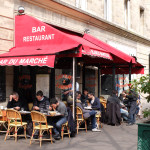
On a cold Sunday, cloudy and only 10 degrees Celsius (about 50 Fahrenheit), the cafes in the Chatelet and Marais districts of Paris were busy. Some patrons sat inside; most sat within the inside/outside, that half protected zone with canopy covering and (potentially) heat lamps. And then there were all the rugged ones – surprisingly many – who sat by those tiny cafe tables, sipping their espressos, quaffing their wine and drawing on their cigarettes.
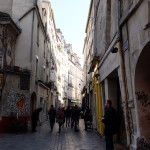
The bustling boulevards on the right bank of the Seine offer boutique after boutique, each supporting a sumptuous 19th century building. Follow the Rue de Rivoli to the west, you’re amid the grandeur of the Louvre, Tuileries, the Champs Elysees, l’Etoile. To the east, though, you can meander the narrow, medieval streets of the Third and Fourth Arrondissement, with its looming 4 to 5 story buildings neatly replastered and repainted but often somewhat aslant. That’s the district in which we were fortunate to find our apartment. The many pedestrian-mainly streets and places (courtyards) – strangely quiet in the middle of the city – offer the cafés, bars and brasseries so favored by the hearty Parisians.
Soon after arrival, we joined them on the walkers-only street of the Rue St. Denis, which features an endless array of eating and drinking places ranging from the ritzy to the lowlier fare of an Australian pub and numerous pizza joints. Burly men with pints in hand spilled out of what appeared to be an English pub. We chose a brasserie where we could sit along the window of the inside/outside section, a location great for people watching. On our table, we enjoyed a nicely gooey onion soup and a tasty galette of ratatouille and egg, together with a carafe of wine of course. Along the street before us strolled the young and the old, gentry and students in the black/grey uniform of the big city, tourists in matching jackets, map-followers, dog walkers trailing tiny dogs, young parents wheeling tiny babies, tightly bundled homeless and pensioners marking time. The menu displayed at the front door attracted many of the passers-by, who were greeted spiritedly by the owner springing through the door.
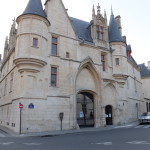
But the Parisian stalwarts exhibited great sang-froid, occupying outside seats close by the flow of walkers, braving the cold and wind on this overcast day, and vigorously conversing. And it wasn’t just because this was a free day, a Sunday. The next day, locals thronged the outdoor tables. The weather was a bit less chill, with persistent sunshine and an extra 5 degrees Celsius in the air. But it was anything but balmy. Cafe owners even disdained to light up the heat lamps to take a bit of the chill off. And shouldn’t these folks be at work? What is the attraction?
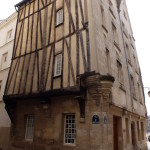
We had decided to be part of the flow on this Monday, with our own walking tour of the neighborhood – wandering past 900 years of Parisian life…from the medieval residence of the Hotel de Sens near the only remaining wall segments of older Paris.

To the elegant 17th century square of Place des Vosges surrounded by 39 charming red and white brick buildings surmounted by blue roofs.
To the 19th century Jewish ghetto where you can still buy artful bagels, roulades, braided challah and vegetarian borek, to fancy shops with high end brands on Franc-Bourgeois street…as well as the fancifully decorated Jesuit church of St. Paul St. Louis.
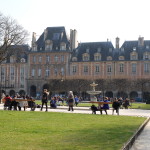
We finished along the Seine, across from the pleasant facades of the Ile Saint-Louis, with the towers of Notre Dame peeking over them.
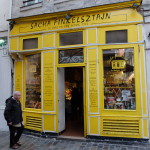
By late afternoon, as the sun was dropping away, we strolled into the Place Ste. Catherine, a cozy rectangle of cobbled brick, trees and benches. Only about 30 meters by 20 meters, the courtyard offered five different cafes, the most popular of which was busy with people of all ages, yes, sitting outside in the chill.
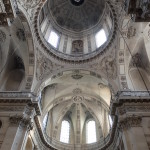
We opted again for an inside/outside table as some protection from the cold, for none of these cafes had turned their heat lamps on. A few tables away four young women eagerly discussed a history lesson involving Metternich, the Austrian diplomat instrumental in arranging peace with Napoleon, along with the emperor’s marriage to an Austrian archduchess, then sending him into exile. The women kept at it for hours while we savored a large, inexpensive cheese assortment with our carafes of wine.
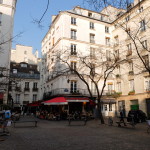
At the next table were two 50-something men in vivid private conversation. They looked so typically French they might have been recruited for local atmosphere. When they left, the one with deeply lined face and bulbous nose snatched the bill and treated his friend to his meal. Within the plaza, a young man worked at his iMac on a bare bench. Few people crossed the space. City noise seemed exiled by the harmonious stony buildings surrounding the plaza.
Surely it’s the whole experience of outdoor Paris that draws locals to the cold tables – and away from the office: the coffee and conversation, the smoking and the food, the carafes of tangy wine, the people traipsing by. We might choose to be among the inside/outside set in the uncongenial weather, but we give the Parisians credit for their sang-froid, their willful disregard of the chill in the air.
After walking through the Marais and idling at Place Ste. Catherine, we couldn’t help but think there’s one thing more that draws them out. That would be the still backdrop of Paris, those elegant old buildings everywhere. Decorative wood doors, wrought-iron balconies, sculpted windows, mansard roofs, hundreds of years of architecture and history sequestered within even the plainest of them – a wondrous world to immerse yourself in no matter where you sit in these districts, no matter what the conditions are.


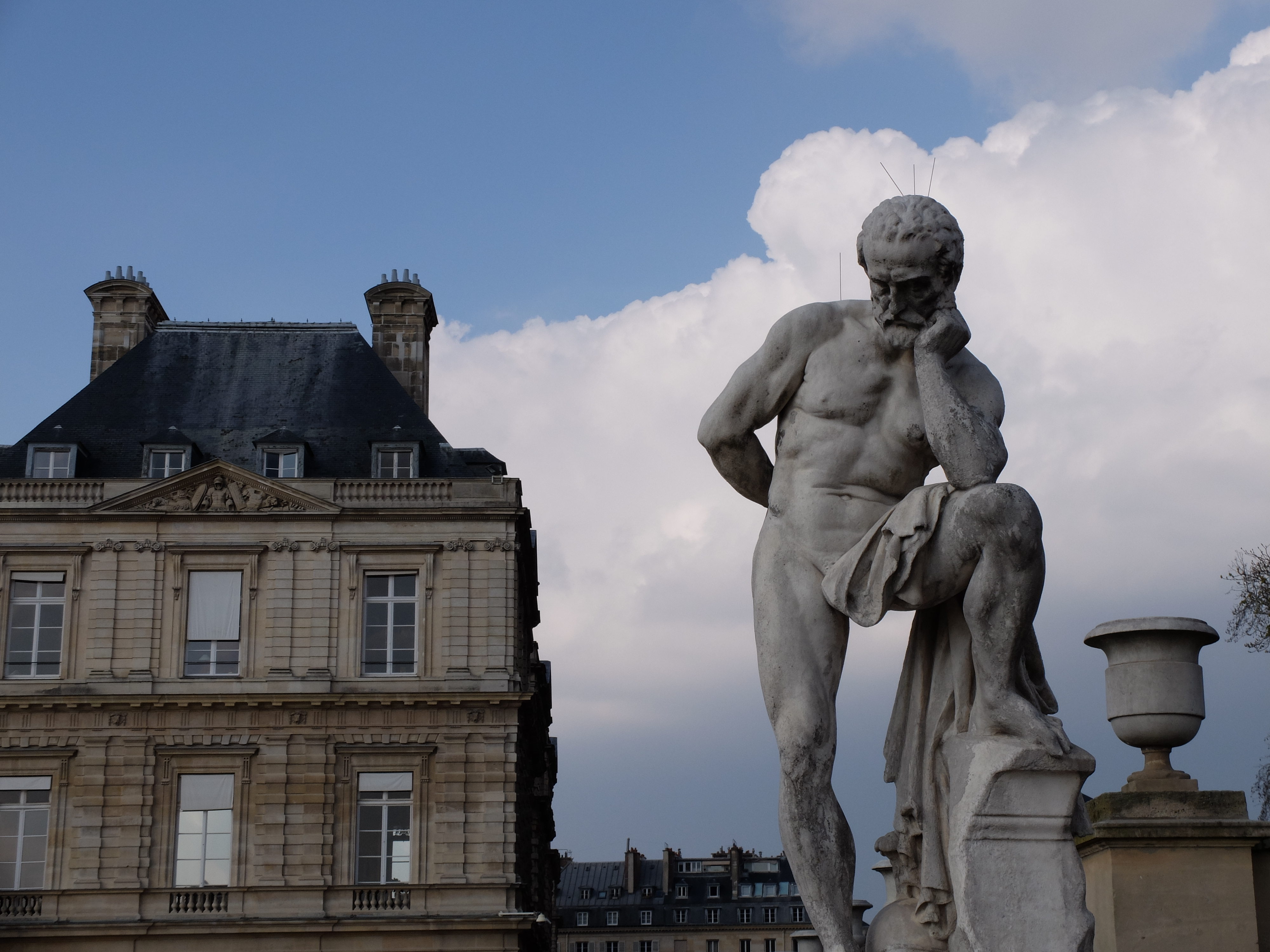
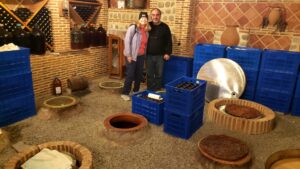
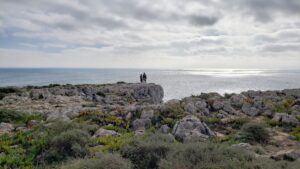
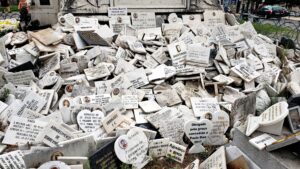
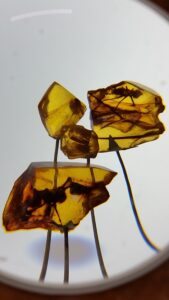
maybe they are desperate like us to get outside, despite this
New Yorkers can relate, I agree. They don’t quite have as many opportunities to sit on the streets perhaps.